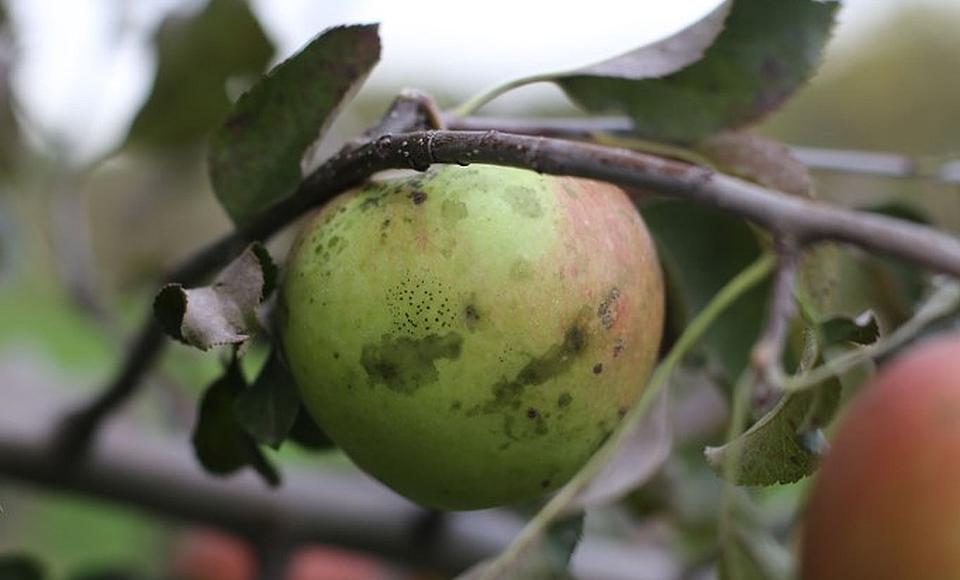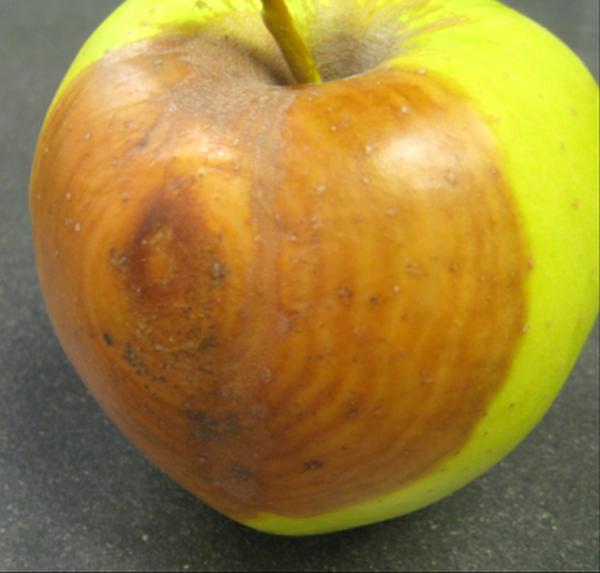It’s Never Too Early to Prevent Apple Summer Diseases and Rots

Sooty blotch and flyspeck are seen on this apple. (Photo: Kerik Cox)
When it comes to summer disease and rots, there’s a lot of usual suspects — whether it’s sooty blotch and flyspeck or black and white rot. But the most important thing to keep in mind is your susceptibility to diseases from petal fall on.
And with many orchard diseases, if your management in 2018 was subpar, it’s safe to say you’re more at risk this year. So, coming out of dormancy, your most important control measure is to clean up your orchard, especially the orchard floor.
You could apply urea in the fall before leaf drop, but since that’s past, you can apply it in the spring. Urea encourages earthworms to clean up debris on the orchard floor. Some summer disease inoculum, such as black and white rot, lives in pruned-out mummies and rotten wood on the orchard floor.
Organic growers can opt for 2.5 pounds per gallon of lime to help clean up the orchard floor.
Early in the Season
Kerik Cox, Associate Professor of Plant Pathology at Cornell University, says growers should think about any wood that has been pruned out from fire blight strikes too, as that dead tissue can cause more harm than good.
“Sometimes we’re not so worried about fire blight living in dead tissue, but the other things will start sporulating and start looking for a new piece of fruit or a new, fresh, piece of wood,” he says. “Those summer rot fungi can typically also eat wood, so they can just burrow in there and when the sugar runs out, they switch to spore-making mode. The next thing you know, they’re on your fruit.”
Cox also suggests growers apply a copper spray for clean up after bud break, too. Since summer diseases are likely to get shot in the air, this step is one not to be missed.
One thing growers need to keep in mind as leaves and shoots start to grow after petal fall, there is unprotected surface area that is exposed. So, it’s important to follow disease models and spray cover sprays as necessary. Growers may need to start with a strong copper spray if there’s a higher infection risk, Cox says.

Black rot is seen on this apple. (Photo: Kerik Cox)
Prevention Tips
“There are a lot of varieties that have thinning mummies. All of those are just chock full of summer diseases,” Cox says.
So, it’s important to start the season with a clean orchard floor. Removing or reducing the amount of inoculum in the orchard will give your fungicides boost.
“It’s not going to be your silver bullet, but it’s going to reduce inoculum sources,” Srdjan Acimovic an Extension Associate at the Cornell University’s Hudson Valley Research Laboratory.
says.
Watch models on NEWA, the Network for Environment & Weather Applications, to help you determine when you’ll be at risk for sooty blotch and flyspeck.
“If they had some wide intervals for summer sprays, then they might need to be more aggressive in the spring,” Cox says.
Acimovic also cautions growers to not get complacent during a dry spell or think you can stretch your cover sprays to save money.
“With higher rain amounts, the diseases have a huge potential to produce spores,” he says. “They’re microorganisms, so they have billions of spores and it’s a game of numbers. The more conducive the conditions are, the more production they’ll have. If the rain is perfect, they’re going to spread around and infect.”
Remember that drought-stressed trees can be an invitation for opportunistic pathogens. It’s also important to continue with your cover sprays to protect late-season varieties, which extends into September, October, and November.
Resistance management also goes without saying. There are ways to combine efforts, as some FRAC GROUP classes are effective on treating sooty blotch and flyspeck as well as white and black rots. Most of the FRAC groups have a maximum number of applications within a season, too.










